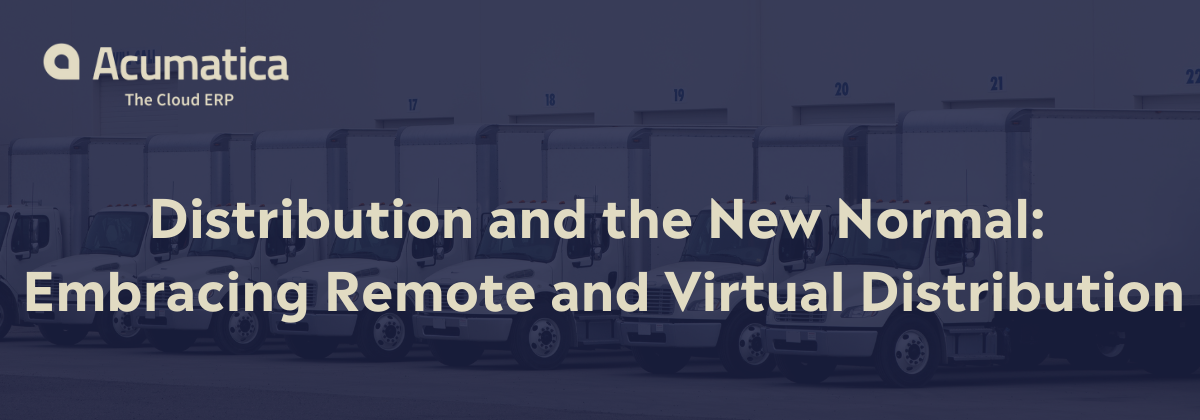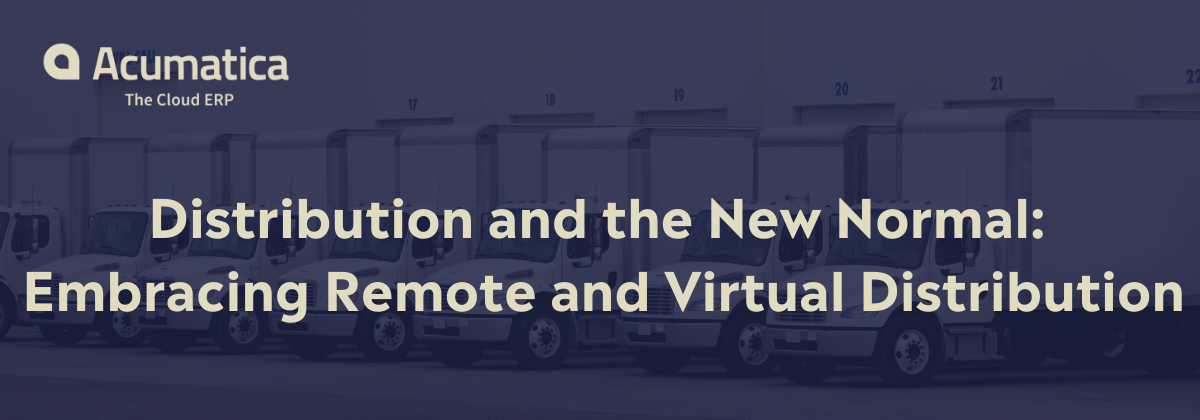Here’s how cloud ERP can help distributers leverage remote and virtual distribution across operations and workflows.
Using Virtual Distribution to Navigate Industry Disruptions
“Disruption” has probably been the second most used word in the last few years, surpassed only by “unprecedented.” Both reference the unexpected (another oft-used word) COVID-19 pandemic that altered the existence of every person and business on the planet. All industries, whether deemed essential or not, were affected, and the distribution industry is no exception. Not usually known as the harbinger of innovation, distributors are struggling to overcome pandemic-induced challenges using a method that is semi-foreign to them: virtual distribution.
What is Virtual Distribution?
Virtual distribution can be subdivided into two forms: selling a digital service (vs. a physical product) and delivering a physical product through a virtual channel (like an eCommerce platform).
An eCommerce platform is a software application that sellers (in this case, distributors) use to manage their websites, display their products, provide information about their products and policies, and allow customers to make purchases without physically entering a brick-and-mortar store. The best eCommerce platforms seamlessly integrate with a cloud ERP solution, which helps companies manage front and back-office tasks, including accounting, sales, customer relationship management (CRM), inventory, and more.
Utilising an eCommerce platform integrated with a cloud ERP solution, distributors can easily manage virtual distribution selling methods, such as dropshipments. Dropshipping is where the distributor acts more as a marketing company—developing and closing sales leads—and their supplier fulfills the order directly with the customer. In this scenario, the distributor creates or captures the sale from the customer, creates a purchase order for the item from the vendor, and the vendor ships the product directly to the customer. This may be a popular option for distributors who are expanding product lines, have limited warehouse space, and who want to shorten fulfillment lead time by avoiding shipments to their facilities.
Keep in mind, however, that moving to virtual distribution doesn’t have to be an “all or nothing” choice. Using an omnichannel selling approach (e.g., multi-pronged selling through online, in person, or phone channels) creates a “best-of-both-worlds” reality.
Even so, it may be hard to convince traditional distributors to change their mindsets.
Changing Industry Mindsets
Distributors are facing many challenges today, which, according to a Deloitte analysis, include: “accelerating digitisation, expanding competition, emerging customer demand, product innovation, continuing disintermediation, and consumerisation of expectations.”
The Deloitte analysis also explains that traditional wholesale distributors are cautious about expansion and “are often less accustomed to seeing the emergence of new competitors leveraging completely new business models, rapid advances in and adoption of new technologies, or seismic shifts in how customers want to interact and transact.”
Unfortunately, being unaccustomed to something does not stop it from happening. As a case in point, many organisations had to quickly transform from in-person to remote workforces during the pandemic, though remote work was something they had never done. Distributors who are considering or already pivoting toward the remote distribution model and virtual distribution have more than likely experienced an uncomfortable transition.
Thankfully, the benefits of virtual distribution help counteract the concerns. These benefits include improved customer experiences, easier data capture and analysis, and stabilised cash flows. An article from BakerTilly—an advisory, tax, and assurance firm—mentions further benefits: data-driven charts and graphs, error-free processes driven by intelligent automation, and spot-on sales pitches informed by real-time business intelligence. According to BakerTilly, “[w]hen implemented correctly, remote selling leverages technology, business intelligence, automation and proper oversight to connect with customers, drive sales and maximise profits.”
Using Cloud ERP to Manage Changing Virtual Distribution Channels
Virtual distribution requires a designated channel, such as an eCommerce platform. And again, the best eCommerce platform is one that connects to a cloud ERP solution.
A cloud ERP solution is a comprehensive business management tool that incorporates all of an organisation’s departments and applications into a centralised system. Financials, sales, marketing, operations, and third-party application data flows into—and out of—this single location, giving employees access to updated, synchronised information. And because it is cloud based, the ERP solution can be accessed through any web-enabled device, from anywhere, at any time.
How Acumatica Can Help
For distributors, choosing cloud ERP software that meets their specific needs means doing some homework and comparing the various features and functionalities of each ERP option. They should focus on whether an ERP solution has both distribution-specific software and eCommerce capabilities (either built into the solution itself or available through integration with an eCommerce platform).
There is a solution that meets all these criteria and more: Acumatica.
Acumatica’s Wholesale and Distribution Software integrates and automates the quote-to-cash cycle and provides configurable workflows. It offers open APIs, so it can be connected to distribution applications of the user’s choice, such as eCommerce applications. Acumatica also has its own Retail software and has partnered with key eCommerce platforms, including BigCommerce and Shopify.
Worldwide, consumers spent over 4.2 trillion U.S. dollars online in 2020, and, as the pandemic continues to spur eCommerce forward, it is imperative that distributors jump on board the virtual distribution train. If and when they do, they’ll be setting themselves up for success in a future that is embracing the “new normal.”
Acumatica can help distributors transform from traditional to virtual distribution processes. Contact Acumatica Partner, TRC Solutions today.

